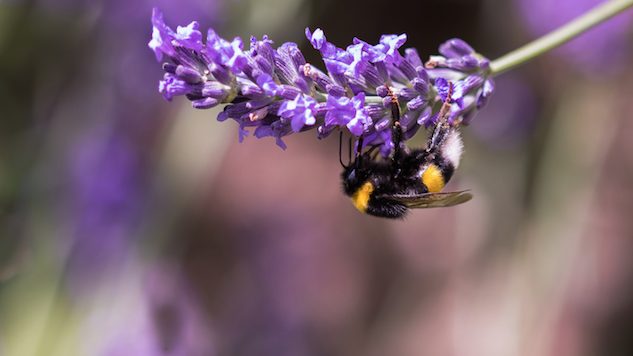How to Bring Bees and Other Beneficial Insects into Your Garden

Of the 100 crop species that provide 90 percent of the world’s food, more than 70 percent of them are pollinated by bees. Nuts, fruits and even root vegetables; they’re all here thanks to bees. Bees are an essential part of our food chain — we all depend on them for our own survival — but today they are threatened by colony collapse disorder, putting our entire food system at risk.
“Pollination by insects is essential for many plants to produce healthy fruits and seed,” says Hilary Dahl of Seattle Urban Farm Co. “The majority of the food we eat is pollinated by bees and other flying insects. Without insect pollination most fruits and vegetables will not set fruit at all or the fruit will be incomplete and likely to rot or fall off the plant.”
If you have a little garden space, or even just a balcony with room for pots, planting a bee-friendly garden is a way to ensure that these important pollinators have the habitat they need to survive. “An effective bee-friendly garden doesn’t have to be large, nor does it have to be complicated,” write Kate Frey and Gretchen LeBuhn in The Bee-Friendly Garden, an excellent resource for anyone looking to bring more pollinators to their garden. “You can begin with a bare site and develop a bee-friendly garden from scratch, or you can simply incorporate some bee-friendly plants into an existing garden.”
By planting a bee-friendly garden, it’s not just the bees that will benefit. Many of the same plants that bees love also attract beneficial insects, ones that will help you to deal with pests and infestations. Ladybugs for example can be used as natural aphid control, and ground beetles help to protect against caterpillars and slugs.
If you’re looking to plant a bee-friendly garden this spring, we’ve rounded up a few helpful tips.
Go Organic
Keep pesticides and chemicals out of your garden to keep the bees thriving. This goes for plants as well; some nursery plants are treated with bee-killing insecticide neonicitinoids. Opt for certified organic plants and seedlings to ensure that they’re safe for your garden and the bees.
Plant What’s Right for Your Area
Common bee-friendly plants are cosmos, borage, cornflower and sweet alyssum. There are a wide variety of plants that attract pollinators, but the most important part of choosing what you will add to your garden is figuring out what will work best for your climate and soil. Check out a zone map to determine what will be best for where you are located.
Plant a Mix of Annuals and Perennials
Annuals are great pollen sources for bees, and some will even reseed on their own. A lot of annuals are edible as well — both in the form of herbs and flowers — like basil and cilantro (particularly when they go to seed). Some people may prefer planting bee-friendly perennials, as they don’t need to be replanted every year. Bee-friendly perennials include lavender, catmint, anise hyssop and thyme.
-

-

-

-

-

-

-

-

-

-

-

-

-

-

-

-

-

-

-

-

-

-

-

-

-

-

-

-

-

-

-

-

-

-

-

-

-

-

-

-








































